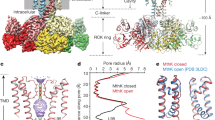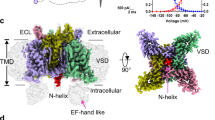Abstract
BIOCHEMICAL investigation of membrane components involved in ion-specific conductance changes is difficult because of the lack of a functional assay for the components after membrane solubilisation. Proteins thought to participate in conductivity changes during synaptic transmission1 have been isolated using a binding assay and affinity chromatography2,3, because of their high affinity for a variety of ligands; but the connection between such receptor proteins and postulated ion channels remains to be shown. To isolate molecules forming sodium channels of the axon membrane4–7, tetrodotoxin was used as ligand (binding assay Kd=3 nM). The most efficient known blocking agent of the change in potassium conductance in nerve and muscle known is tetraethylammonium (TEA) but its affinity is too low (Kd=0.4mM (ref. 8)) for either of the above techniques. We have attempted to label radioactively those molecules associated with the voltage-dependent potassium conductance changes covalently in situ with the aim of recovering that radioactivity after solubilisation using classical fractionation procedures. We suggest that it is possible to block selectively and irreversibly potassium conductance in myelinated nerve fibres using a photoaffinity lable. This method may open the way for the isolation of the TEA receptor of excitable membranes, proposed as part of the potassium channel (if not the channel itself).
This is a preview of subscription content, access via your institution
Access options
Subscribe to this journal
Receive 51 print issues and online access
$199.00 per year
only $3.90 per issue
Buy this article
- Purchase on Springer Link
- Instant access to full article PDF
Prices may be subject to local taxes which are calculated during checkout
Similar content being viewed by others
References
Cohen, J., and Changeux, J.-P., A. Rev. Pharmac., 15, 83 (1974).
Meunier, J.-C., Sealock, R., Olson, R., and Changeux, J.-P., Eur. J. Biochem., 45, 371 (1974).
Karlsson, E., Heilbronn, E., and Widlund, L., FEBS Lett., 28, 107 (1972).
Benzer, T., and Raftery, M. A., Proc. natn. Acad. Sci. U.S.A., 69, 3634 (1972).
Benzer, T., and Raftery, M. A., Biochem. biophys. Res. Commun., 51, 939 (1973).
Henderson, R., and Wang, J. H., Biochemistry, 11, 4565 (1972).
Henderson, R., Ritchie, J. M., and Strichartz, G. D., J. Physiol., Lond., 235, 783 (1973).
Hille, B., J. gen. Physiol., 50, 1287 (1967).
Kiefer, H., Lindstrom, J., Lennox, E. S., and Singer, S. J., Proc. natn. Acad. Sci. U.S.A., 67, 1688 (1970).
Nonner, W., Pflügers Arch., 309, 176 (1969).
Nonner, W., Rojas, E., and Stämpfli, R., Pflügers Arch., 354, 1 (1975).
Fox, J. M., Pflügers Arch., 351, 287 (1974).
Armstrong, C. M., J. gen. Physiol, 58, 413 (1971).
Armstrong, C. M., and Hille, B., J. gen. Physiol., 59, 388 (1972).
Author information
Authors and Affiliations
Rights and permissions
About this article
Cite this article
HUCHO, F., BERGMAN, C., DUBOIS, J. et al. Selective inhibition of potassium conductance in node of Ranvier with a photoaffinity label derived from tetraethylammonium. Nature 260, 802–804 (1976). https://doi.org/10.1038/260802a0
Received:
Accepted:
Published:
Issue Date:
DOI: https://doi.org/10.1038/260802a0
This article is cited by
-
TEA binding sites in crayfish axon membranes
Nature (1977)
-
Biochemical investigations of ionic channels in excitable membranes
Molecular and Cellular Biochemistry (1977)
Comments
By submitting a comment you agree to abide by our Terms and Community Guidelines. If you find something abusive or that does not comply with our terms or guidelines please flag it as inappropriate.



